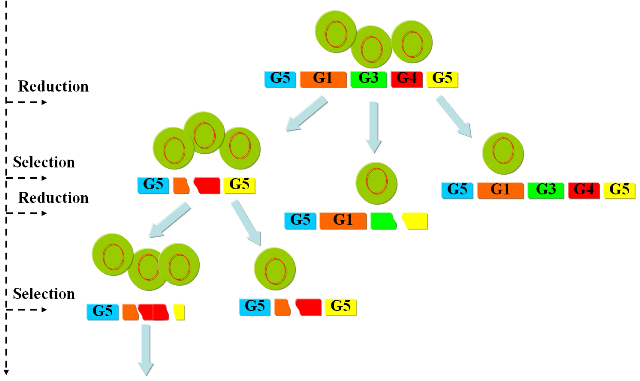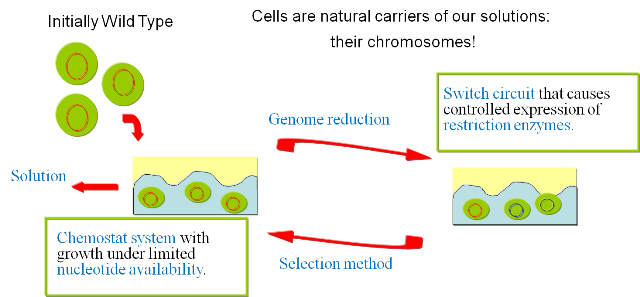Team:ETH Zurich/Project/Approach
From 2008.igem.org
| Line 9: | Line 9: | ||
<!-- PUT THE PAGE CONTENT AFTER THIS LINE. THANKS :) --> | <!-- PUT THE PAGE CONTENT AFTER THIS LINE. THANKS :) --> | ||
| - | + | __TOC__ | |
== Random walk towards a minimal genome == | == Random walk towards a minimal genome == | ||
Revision as of 02:17, 30 October 2008
Random walk towards a minimal genomeThe concept we are trying to follow is based on a massively parallel random search. We have developed a top-down approach that will enable us to dramatically reduce the genome size of a living organism. As we described in the previous section we are looking for a minimal subset of genes that are able to sustain life. The main problem when following this type of approach is the combinatorial possibilities that lead to a hugh solution space, this corresponds to a classical NP-problem (non-polynomial) in computer science. The number of combinations of the original set of genes is given by:
We propose the following algorithm as a method to find solutions to the presented problem: Evolutionary algorithm: 1. Take the elements of current solution population (our populations in the chemostat). 2. Mutate them according to some evolutionary rules (pulse restriction enzymes and ligases). 3. Test the fitting of each solution (grow in continuous culture under selective conditions). 4. Bring only the fitter ones to next generation. 5. Go to step 1
We then follow the new "paths" to test the fitness of our solutions and select for the ones that have successfully reduced the genome. These solutions are amplified by our continuous culture environment and represent the starting point for the subsequent round of mutations. By iterating this process we should be able to follow a biased "random walk" towards the minimal genome and gradually reduce the genome of our target organism.
ImplementationIn order to prove the viability of the concept, we have developed a series of models and of biological experiments that are introduced in this section. For details on the results of the single steps we refer to the specific sections in the Wetlab and the Modelingsections. Figure 1 gives an overview of the developed system and illustrates the final experimental setup.
The iteration of the following steps gradually reduces the size of the chromosome: 1) Excision of genomic sequences by restriction enzymes and ligases. We have developed a genetic circuit that allows us to generate a controlled pulse to control the expression of restriction enzymes and ligases. Our assumption is that by carefully selecting the timing of the pulse, we can cut fragments of the chromosome, that in a number of cases will be lost when the chromosome is religated. To test this principle in vivo we have developed a proof of concept that will show the potential viability of this method (genome reduction). 2)
a) .. excision of genomic sequences by restriction enzymes can be performed within the living cell; b) .. fragmented genomic DNA can be ligated inside the living cell by simultaneous expression of T4 ligase; c) .. pulse generators that produce pulses of protein expression of variable length terminated by induction with a second compound can be devised both on the transcriptional as well as on the translational level; d) .. cells with optimized growth and reproduction can be selected by competition inside chemostat cultures. Random walk towards a minimal genome |
 "
"


